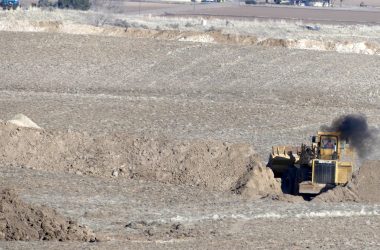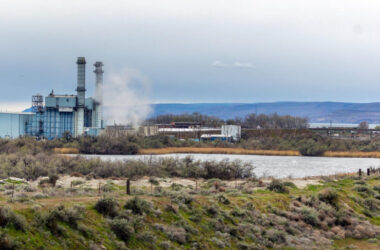VALE – The Treasure Valley Reload Center has reached yet another critical moment, with managers saying they need the state to break its embargo on more money so key tasks can get done.
The Malheur County Development Corp. board tasked its staff and consultants to hit up the state for $1.2 million it was told might be available to pay engineers and more consultants.
“We’ve gotten as far as we can without these next steps of critical work that will cost a little bit,” said Shawna Peterson, executive director of the development company. She estimated that MCDC would need up to $250,000 immediately to continue progress.
But officials at the state Transportation Department say they are unlikely to free up funding soon. The state agency for months has been waiting for project managers to show it has retained someone to run the Nyssa rail depot and that they have a clear plan to raise millions more needed to finish.
State officials have been working with the MCDC project team on a new business plan that would get the terminal done and operating. Transportation Department officials warned last August that without solid plans, the state may stop its participation.
“It is paramount we focus on changing the development’s reputation.”
–Draft report for Malheur County Development Corp.
“We’re still trying to get the information to feel good about making a go/no go decision,” Erik Havig, a Transportation Department planning manager, said in an interview last week.
A consulting firm advised the development company board on Tuesday, April 2, that the stalled project faces significant challenges. The consultants presented a draft report that said one challenge is turning around opinion about a project that is far over budget and years behind schedule.
“It is paramount we focus on changing the development’s reputation,” said the report, prepared for MCDC by the Boise consulting firm Axiom. “Confidence, certainty, and clarity needs to be communicated utilizing the project plan, the new project organization, and the state’s renewed support.”
The report also said that “this new reputation will be needed to secure industry partners to fill key roles in the execution of the design and construction.”
The board also considered yet another budget projection. The budget, though, left out $5 million in state funding that would be released when MCDC meets certain conditions. The budget also showed $3 million remaining from a prior legislative appropriation, but state officials said much of that has already been spent. Just $800,000 remains of previous funding, according to the Transportation Department.
Peterson said after the meeting that money amounts in that document should be treated as a “placeholder” and cautioned against the draft budget “being misinterpreted or appearing deficient.”
She said there was “nothing opaque or sinister” about draft documents such as the budget presented last week.
Peterson didn’t answer detailed questions sent to her twice about that draft budget. She said she will not have “updated numbers until I get direction and approval from ODOT” on next steps.
She also responded to draft excerpts of this story provided to her to ensure accuracy.
“Please cease your use of erroneous or misleading statements that unfairly disparage competence,” she said in an email to the Enterprise on Monday, April 8.
Questions over numbers continue to dog the project. A month ago, for instance, MCDC told state officials they were budgeting $1 million for unexpected costs. Such costs have popped up regularly as construction started. But the budget document given the board reduced that emergency fund to about $230,000.
The development company doesn’t have funding of its own, depending on the state for the bulk of money for a project last estimated to cost $41 million. MCDC has relied on continued funding provided by the Malheur County Court to cover daily costs such as staffing, accounting and consulting services.
Peterson and Axiom representatives made clear at the recent meeting of the development board there was urgency for getting the state to release funding reserved for the Nyssa project.
Without the infusion of cash, the project could be years from completion.
Peterson said in an interview that the money would fund work by consultants to analyze potential shipping routes from Nyssa to the east, to update building construction costs and to identify companies to handle the shipping.
In the past few months, the development board has considered a series of options regarding destinations for onions that would be shipped east by rail car.
The state money would pay an industry expert to come up with new shipping options, replacing work done in previous years by industry shipping giant Americold. That company was to run the Nyssa facility but backed out after judging the reload center was no longer feasible for the company. Americold had detailed shipping routes and onion volumes to several markets in the east.
Money also is needed to assess construction of the facility’s main warehouse. Now, the building sits on the ground in pieces north of Nyssa. The corporation has yet to decide on costly features such as fire and heating systems for the building.
And rail lines serving the reload center still need to be completed.
Construction on the project is stalled after the development company ran out of money, costs continued to escalate and contractors cleared out.
Last August, the Transportation Department froze funding for the project and set two crucial conditions before it would release any more.
The state is insisting the development company provide a plan for how it will raise $5 million to $6 million still needed to build the depot.
Project officials had recently calculated they could borrow the needed money, repaying a loan with fees on shipments. No such financing has been arranged.
The recent draft report said possible lenders included the Eastern Oregon Border Economic Development Board, for which Peterson serves as the executive director. Last year, project leaders were turned down when they requested $1.5 million from that board. Other potential funders, the report said, could include Ag Bank and state loans.
The Transportation Department also has insisted that a new operator be on board to replace Americold. Project managers are considering having the development company itself handle some depot operations while retaining another company to handle shipping details.
Peterson said she is waiting more information from Commtrex, a Texas rail logistics firm, regarding destinations for the reload center’s onions and pricing for shipments.
Peterson said she’s seeking details on “advantageous pricing and the availability of rail cars.”
The consultants and Peterson said last week that existing designs for the partially-done depot needed review before construction could start up again.
That means the corporation will need to hire an engineer “to go over the plans and the budget,” said Peterson. “Let’s dust off the plans and make sure all the permitting is on line.”
Nathan Harrison, an executive manager with Axiom, told the board that engineers or contractors agreeing to work on the project would first need to evaluate the work already done since they would be assuming responsibility for the entire project.
Harrison also said the availability of contractors has “gotten worse” since project managers first sought bids for building construction. He said the demand for skilled labor and supply chain issues remain.
He also noted that potential contractors may be less interested in taking on a partially-done project when there is demand for their expertise on new ones.
Harrison also said industry experts have indicated rail car availability and the relatively small size of the reload center could be challenges.
The rail car issue isn’t new. That has remained unresolved for years and officials considered several options – including buying, leasing or using Union Pacific Railroad’s inventory – to solve the problem.
“Obviously bigger operations will get more attention,” he told the board.
Harrison told the board that industry experts were also concerned about “if it is just reloading and not shipping does it have enough capacity to encourage the right investment or partnership.”
Mike Walker, a board member with project experience, said the development company had to start work soon to be ready for the 2025 harvest season. He said if construction wasn’t completed by next winter, the reload center likely wouldn’t operate until 2026.
The consultant’s report projected that if the development company started immediately to revive the project, the reload center could be ready for business by February 2025.
Previous coverage:
Rail center plan projects no more taxpayer support, big savings for onion industry
Consultant: Unclear business plan, incomplete design impede Nyssa rail center
Permit glitches impede progress on rail reload project
HOW TO SUBSCRIBE – The Malheur Enterprise delivers quality local journalism – fair and accurate. You can read it any hour, any day with a digital subscription. Read it on your phone, your Tablet, your home computer. Click subscribe – $7.50 a month.




